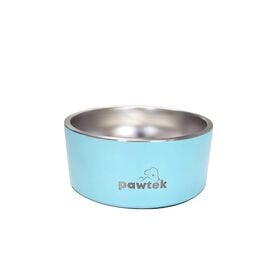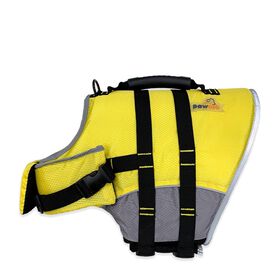In the summer, it can be tempting to toss your pooch into the water for a cool down and a little fun. Contrary to popular belief, knowing how to swim is not in every dog’s DNA, and forcing a dog to swim can be traumatizing. Here are a few tips for making swimming enjoyable and safe.
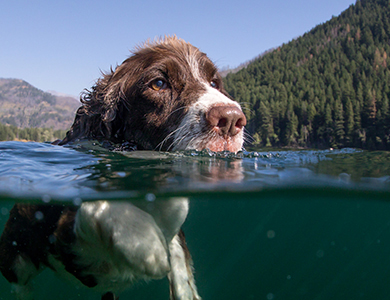
Steps for a successful swim
A first swim is ideal when puppies are less than six months old. Swimming can also be introduced as a fun activity at any age, as long as you take the following precautions:
- Choose a safe environment
- Protect your dog
- Take your dog’s pace into account
What is a safe environment?
You have several options for making sure your dog swims in a place where he'll feel at ease.
A backyard pool
Why not start with your pool? Be sure that your dog is not in the habit of drinking the water, whether it is chlorinated or salted. Give the dog a drink in the house beforehand or keep a bowl of water near the pool. Also, provide an access so that the dog can enter the water on its own.
A natural source of water
It may seem entirely natural to take a dip in a lake or another source of water. However, it is important to be sure that your dog has been vaccinated against leptospirosis, a disease caused by bacteria found in some sources of water. Also, if your dog tends to be adventurous, use a tether (a 15- to 30-foot leash) to pull it back if it wanders off. Dogs usually like getting into the water gradually and wading without having to swim. This is therefore a good option for more tentative dogs.
A pool in a controlled setting
Indoor pools for dogs are becoming increasingly popular, and are another option. A few places in Quebec offer access to a pool specifically designed for your furry friend.
Although it is not always possible to get into the water with your dog, an instructor is usually on hand to help your pet transition smoothly into the water.
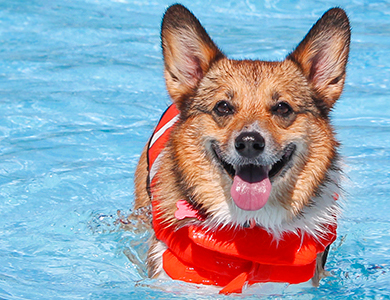
How to protect your dog?
By taking certain precautions and being attentive to your dog's needs, you can ensure that swimming is a fun and safe experience.
Before the swim
Don’t forget the lifejacket! Yes, that’s right! It’s the ultimate accessory that should be mandatory for all puppies and dogs venturing into the water for the first time. It prevents drowning, which happens much more often than you might think, and will boost your dog’s confidence because the flotation device provides extra support.
Bring along some floating toys and treats to help make getting into the water a positive experience for your dog.
During the swim
Even if your dog has a great time in the water, it shouldn’t stay in for more than 15 to 20 minutes at a time. It’s hard to know whether a dog is exhausted when it’s in the water, and it won’t tell you if it’s out of breath. Start off the season with a short five-minute swim, and gradually increase swim time as the season progresses.
To avoid “accidents” in the pool, take your dog out of the water during breaks so it can do its business. As with walks, repetitive swimming movements will stimulate your dog’s urinary and digestive system.
After the swim
After your dog gets out of the water, it is very important to rinse in order to get rid of any impurities that can cause skin infections. Keep in mind that if the water is not clean enough for you to swim in, it probably isn’t for your dog either.
Drying your dog is the last critical step. Avoid letting your dog air dry, since this can lead to pyodermatitis—also known as a hot spot—a skin infection often seen in long-haired dogs. It is also recommended that you clean your dog’s ears after swimming to help prevent ear infections.
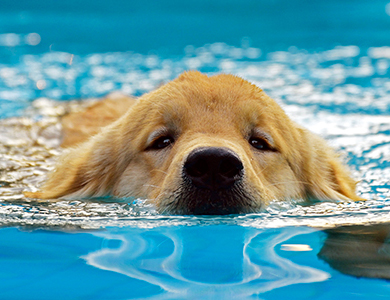
How to introduce your puppy into the water
- Let your puppy enter the water on its own, using toys and treats as enticements.
- Once the puppy has all four paws in the water, be sure it still accepts food. If it refuses, take it out of the water and go back to the previous step.
- Be sure that your puppy can turn around in the water on its own. With another person, take turns calling it.
- Never let your puppy claw its way out from the edge of the pool. Always encourage it to go to the shallow end. This step is recommended to avoid drowning.
- Be sure that your puppy plays in the water on its own with floating toys.
Although you can’t teach a dog to swim, you can create winning conditions that will help your dog get used to swimming.





